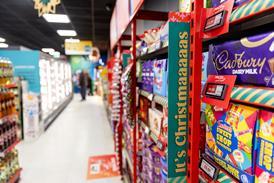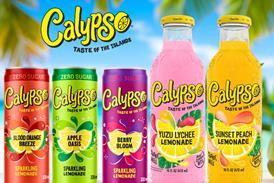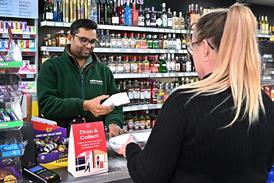Life is sweet when it comes to selling chocolate, it seems.
Over the past year the chocolate market has enjoyed 0.9% growth, reaching a total value of £3.9bn, and within the convenience channel chocolate confectionery sales are up 2.3%, according to Mars Chocolate.
And what’s driving this growth: sharing bags. “Bags and pouches have seen a 12.4% rise in convenience sales over the past year, up £15.5m to approximately £141.5m,” says trade communications manager Bep Dhaliwal.
“Chocolate is going really well in our shop, especially pound bags,” says Nipa Modhvadiya of Mace Whissendine, Rutland. “The big brands such as Cadbury, Galaxy and Nestlé all sell well.”
It’s a similar story at Muhammed Ashraf’s Anam News in Atherton, Manchester. “Chocolate sales are going very well, especially the £1 pricemarked bags,” he says.
Sue Nithyanandan, who owns two stores in Surrey, has also seen great bag sales. “The pouches do extremely well in both of my stores. People like the idea of sharing - they feel better about buying so much chocolate if they are planning to share it (even though they might end up eating it themselves!).
“We’re doing Milkybar Buttons and Milkybar Milkshake Mix Up, Yorkie man-size and Munchies bags for £1 - it’s the magic number.”
“We sell a lot of £1 hanging bags,” says Tony Cristofaro, who owns Spar Landmark Place in Cardiff. “They hang on hooks on a gondola end.”
Binny Amin, who owns two stores in Kent, has three different sitings of chocolate bags in his Blean Londis. “We stock Cadbury Wispa, Minstrels and M&Ms, all pricemarked. It works really well for impulse. We have one by the food-to-go area with crisps and drinks, one by the till point and one by the alcohol for the Big Night In market.”
Dhaliwal agrees that sales of sharing bags are being fuelled by the Big Night In consumption occasion. “Entertaining at home or having a Big Night In continues to be enjoyed throughout the year by shoppers of all ages, as friends and family choose to spend time together in the comfort of their own homes,” she says.
“This broad appeal means that the Big Night In presents a great opportunity for retailers to tap into additional sales, providing the right snacking solutions for consumers looking for the perfect products to complement their evening. The rise in popularity of the Big Night In occasion has resulted in sharing packs playing an increasingly key role in the confectionery market.”
Stephen Archer, who owns three Premier stores near Stoke-on-Trent, has seen great success with Mars bitesize bags. “We’re doing brilliantly with Revels and M&Ms,” he reveals.
He has been busy remerchandising his Congelton store’s chocolate offering in order to give bags greater precedence. “We’ve taken out a lot of slower-moving countlines and a quarter of countline space has been given to our hanging bags,” he says. “We haven’t lost any noticeable sales on countlines and we’ve seen more than a 50% sales increase in hanging bags. We haven’t added extra lines of hanging bags, just facings.”
His decision to stock more hanging bags makes good financial sense. “A lot of them are pricemarked at £1 and with a decent margin,” he explains. “Generally, the margins are a bit better on hanging bags. We get 18% margin on Cadbury countlines and 22% on hanging bags.”
Building blocks
The pound pricepoint is also working a treat within blocks. “We have £1 bars on the top shelf of the confectionery fixture,” says Tony. “Teasers bars, Galaxy and Cadbury Dairy Milk all do well.”
Binny’s £1 blocks are also attracting plenty of sales. “Galaxy milk, salted caramel and caramel £1 bars are going really well,” says Binny.
He claims that Galaxy outsells all the other blocks at his store. “We had a lot of people switching to Galaxy when Cadbury changed its price to £1.29 and Galaxy was still £1,” he reveals.
However, he states that Cadbury Dairy Milk’s new Medley block, which is pricemarked at £1, is proving a hit. “The new Cadbury Dairy Milk Medley bars are doing really well,” says Binny. “We dual-site the 93g bars with news and mags, which works well. It’s a bit naughty to go down to 93g, though - customers do notice that bars are smaller.”
Stephen witnessed a similar pattern at his store. “When Cadbury put up the price of its blocks to £1.29 they virtually stopped selling,” he says. “Many people switched to Galaxy, which was £1.”
But he, too, claims that sales of Medley are “storming”.
“We’d only had them in a week before we had to order more. We opened up packs so people can try them and everyone who has tried them has bought them. We’re selling more than a box of each every day, and they’ve not even been on TV yet!”
Available in two flavours - dark chocolate chip, caramelised hazelnut & raspberry, and dark chocolate chip, biscuit & fudge pieces - the 93g Medley blocks will be supported by a £3m marketing campaign, including TV, sampling, outdoor, digital and PR activity. The product is targeted at 25- to 44-year-old women looking for an evening treat. While products carry an rrp of £1.49, they are currently available in promotional £1 pricemarked packs for a limited period.
The Premium market
With shoppers focusing so heavily on price it can be tricky to get them to pick up higher-priced, premium lines. Binny Amin, who owns two stores in Kent, has found the answer through sampling and promotional prices.
He has been his introducing shoppers to Divine Chocolate at a promotional price. “We got a really good deal from Brakes,” says Binny. “We paid £3 for a box of 30 and stocked them on the counter. Normally, it would cost about £11 to buy, so at that price I knew I could afford to give it away.”
He gave out samples of the bar in-store and encouraged staff to talk about it. “We encouraged people to try it and let us know what they thought. It was a good training exercise for the staff so that they don’t go for a hard upsell and instead focus on discussing a product with customers.”
Normally, a small bar retails at 70p or 80p, says Binny, but he has been selling three bars for £1. “We have them on and off promotion and people are still buying them. We sold the original bars really quickly and I will continue to stock them at full price.”
Pricemarking’s place
Pricemarking is a key sales driver of chocolate confectionery at Binny’s Canterbury store. “We’ve introduced a lot of pricemarked packs at our new shop. Cadbury and Mars have done a lot around pricemarking, and the flashes stand out well,” he says. “It’s a bit like going back to the old days where you could buy a drink, chocolate and crisps for a pound. Convenience stores were thought of as somewhere you could get good value and I think pricemarks are helping to restore that perception.”
Mars has recently extended its pricemarked (PMP) offering with Mars, Snickers, Twix, Bounty and Maltesers singles all permanently available with a 50p flash. Says Dhaliwal: “PMPs reassure shoppers they are getting the best value for money, and provide the perfect chocolate treat for a night in with friends and family. Retailers not only see PMPs as better value for themselves and their customers, but also as a key footfall driver, attracting more shoppers to store and ultimately generating sales growth.
“As shoppers continue to look for the best deals on their favourite chocolate confectionery, PMPs now account for 60% of sales at independent stores and we expect to see this trend rise again in 2016.”
Jonathan Summerley, purchasing director at Hancocks Cash & Carry, concurs that pricemarked packs offer a strong value proposition. “In the convenience channel pricemarked packs are important for the independent retailer as they offer transparency, ensuring the consumer knows you are as good value for money as the multiples and discounters. Shoppers are becoming more and more price-conscious and savvy as to where they can obtain the best value for money.
“However, it is important the chocolate confectionery manufacturers maintain a decent profit for the retailers. Chocolate is a very tight margin for all involved, but the key is to offer impulse purchases and a selection of own labels to cater for all audiences.”
Indeed, own-label chocolate is proving itself to be a c-store winner. Booker’s Euroshopper chocolate bars at 50p and 60p sell really well at Stephen’s stores. “We sell the milk, white, dark and nut varieties,” he says. “It’s mainly young adults and kids who buy it.”
Binny also stocks Euroshopper chocolate, although he finds it attracts a different customer altogether. “There is a definite market for it and it does sell well,” he says. “If I put it on the main fixture it gets overlooked. Booker is pushing the price and the packaging is very standard and generic, whereas the likes of Cadbury have bright purple packaging and people recognise the brand.
“But when it’s on the counter people see the price flash at 60p and can’t get enough of it. We find a lot of older customers will trade down to it because they are cash- conscious, whereas our younger customers tend to go for a brand.”
Summerley is convinced that there is plenty of opportunity for own-label chocolate. “More retailers are looking to stock better value, lesser-known brands. These can offer the retailer stronger margins coupled with a point of difference, while the shopper gets an interesting and good-value addition to consider,” he says.
“The chocolate market has been dominated by a few big brands for some time and while this continues to be the case, the tougher economy has helped open up the door for own-label chocolate and also lesser-known brands. Shoppers’ loyalty to brands across all grocery sectors has been tested and this has opened up opportunities in the convenience channel with an increasing number of consumers open to selecting the best value option to meet their needs.”
He claims that sales of the firm’s Bubble Bar range, which retails at £1 for a 160g block, have been extremely strong.
Merchandising advice
While price is the main factor in buying behaviour, retailers can increase impulse purchases of chocolate and sweet treats through merchandising, claims Hancocks Cash & Carry.
“Position chocolate and treats close to pay points, on gondola ends, in dump bins and using branded displays,” advises purchasing director Jonathan Summerley.
“Through offering products in these locations customers on treat missions are more likely to grab products on impulse and engage in less-structured buying thought processes.”
Creating displays around particular products is a good way to grab attention, says Summerley. “Cross-merchandise where possible - for example, merchandise a night-in solution again, interrupting what consumers expect to see, grabbing attention.”
Tony Cristofaro of Spar Landmark Place in Cardiff is encouraging his customers to pick up chocolate bars as part of their lunch by ensuring his display faces customers as they walk towards the sandwiches. “We’ve recently moved the chocolate fixture round to make it more prominent, so that it is facing customers as they walk towards the food-to-go area. Now people have to walk around the chocolate display to get to sandwiches and soft drinks, helping sales.”
Stephen Archer, who owns three Premier stores in Stoke-on-Trent, likes to make the most of suppliers’ POS. “Nestlé has some nice shelf-talkers and Cadbury has given us long trays with edging modelled on chocolate pieces, which clearly identifies a Cadbury area within the fixture. If it looks good, customers will pick it up.”
Countlines
While own-label variants do their best to mimic established formats at value prices, the big brands are busy creating new flavours and formats.
After the successful launch of Aero Mousse milk chocolate bar in 2015, Nestlé Confectionery is introducing a caramel variant for a limited period (rrp 62p).
This year the Aero brand will be supported by a £5m media programme, including new TV advertising and bespoke activity for Aero Mousse Caramel via Facebook.
Tony makes a concerted effort to stock new products and get behind brands that are being marketed. “Customers are always interested in new products. We try our best to stock products that are being advertised on TV as there is usually a sales boost.”
He claims that Snickers, Mars Bar and Cadbury Dairy Milk are his top-selling countlines. “Kit Kat Chunky does well, too - the new extra-chocolate variant sold well on a recent Spar promotion.”
Nestlé is investing £4.4m in Kit Kat in the first quarter of 2016 and as part of the brand’s The Break Off campaign, which celebrates the rituals consumers have when eating their Kit Kat. For a limited time all packs will feature a series of fun messages tailored to suit consumers of each format. Singles and multi-packs of Kit Kat four-finger milk will be flashed with ‘The Snapper’ while Kit Kat Chunky milk is ‘The Chomper’ and Kit Kat Chunky extra chocolate will be flashed with ‘The Nibbler’. The brand will be on TV throughout the year, says Nestlé.
Cadbury is also adding interest to countlines with its new Time Out Wafer. Replacing the original Time Out bar, the new line contains 111 calories and is targeting consumers looking for a lighter snack. Featuring chocolate sandwiched between sheets of wafer, the 35p single-finger offering is supported by a range of POS.
The product is already proving popular at Stephen’s stores. “We’ve got the Time Out Wafer on offer at two for 50p and they’re flying,” he says. “It’s a taste of chocolate, but lighter, and the packaging is nice and bright.”
With consumers coming under increasing pressure to watch their sugar intake, it’s no surprise that manufacturers are introducing lighter bars. But while Stephen welcomes lighter options, he doesn’t believe that chocolate sales have been remotely affected by negative press on sugar. “I don’t think sugar awareness has impacted confectionery sales,” he says. “At a weekend or evenings customers are still buying bags of chocolate, and they don’t buy one, they buy three!”
Tony agrees that chocolate is as popular as ever: “Chocolate sales in our store definitely haven’t been affected by the war on sugar.”
Premium confectioner Elizabeth Shaw believes that while consumers might still be buying chocolate, many are opting to control their portions. “There has been a lot of noise surrounding sugar recently,” says product manager Hayley Coggins. “As a result, the confectionery market has been affected as consumers become increasingly more aware of what they eat and how often they eat it, and although the idea of a ‘healthy chocolate’ is met in the main with scepticism, we are seeing people take better control with portion control. So instead of banning chocolate from their diet altogether, we find people having a little bit of luxury every now and again as a permissible treat.”
Sue claims that while some categories have been affected by health concerns, chocolate hasn’t been hit. “People are cutting back on sugar, but I’ve sold more mini eggs this year than ever before. People are still buying chocolate. Families come in and everyone is buying a treat. When it comes to other areas, they might be more careful, but when it comes to chocolate people want to treat themselves.”
Share in the success
Milkybar Milkshake Mix Up is a mix of white chocolate giant buttons and chocolate milkshake flavour giant buttons (110g, £1.59). Nestlé hopes mums that have grown up with the brand will share this twist on a old favourite with their own families.
New products
Galaxy backs Duet range with new flavours
Mars Chocolate UK is introducing a new combination to its Galaxy Duet range. Duet toffee & popcorn (rrp 60p) comprises two fingers of Galaxy chocolate - one filled with a smooth toffee sauce, the other featuring a combination of crunchy, salted toffee and popcorn pieces.
The company is supporting the launch with a dedicated TV push and a media spend of £600,000. The new product will also have a strong presence across social media and digital platforms thanks to a dedicated online launch.
To bring the new product to life in store, retailers will be able to choose from a range of impactful POS and display solutions, including pre-filled units and front of store display.
The toffee & popcorn bar is the latest addition to the Galaxy sub-brand and follows the launch of Duet cookies & cream, and Duet caramel & shortcake, which landed in stores last summer.
“With dedicated investment in TV and media helping to ensure the new product is front of mind for consumers, we encourage retailers to ensure the product is placed in a prominent location in store and use the POS material available to create visible and eye-catching displays,” says trade communications manager Bep Dhaliwal.
Vrinder Singh of Singh’s Premier in Sheffield says: “The positive response from shoppers to the first two Galaxy Duet variants has certainly converted to strong sales and we look forward to the arrival of the newest combination in our store.”
Galaxy is Mars’ biggest confectionery brand in the UK and the nation’s second largest chocolate brand, worth about £218m and growing 4.5% year on year. The firm claims it is the fastest growing top five chocolate brand, and in 2015 was the UK’s most advertised chocolate brand, supported by an £18m spend.
Source
Sarah Britton


























No comments yet